Ponytail palm plants make your living space amazing and are the best friends of the lazy plant parent!
The slow-growing, low-maintenance plant gives offsets in numerous amounts.
Therefore, you can propagate them yourself, creating as many baby ponytail palm plants as you want.
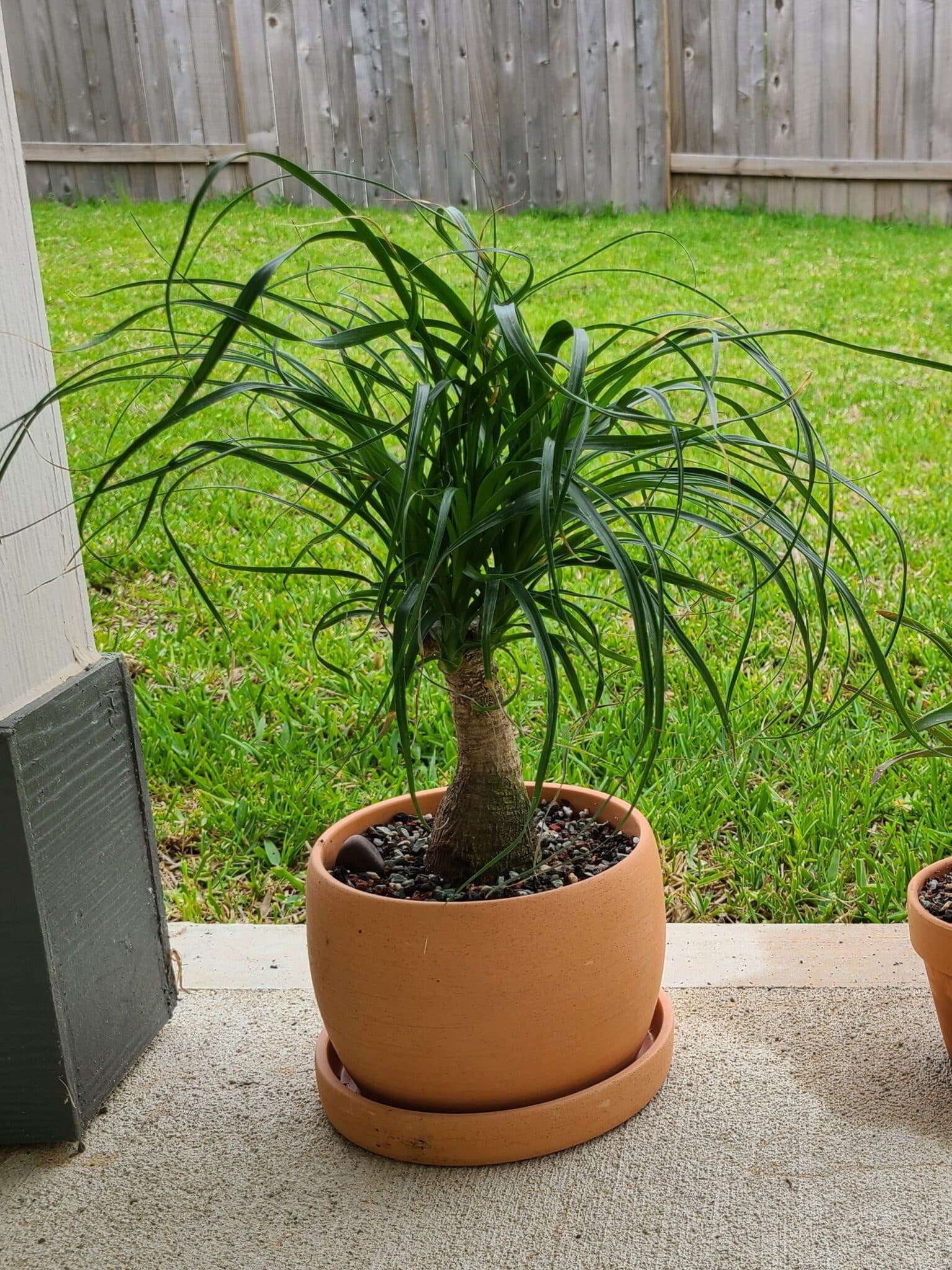
You can either propagate by fresh cutting or layering, and it is your choice!
Read along to learn about propagation time, method, and a few tips that might come in handy while owning a ponytail palm plant.
Table of Contents Show
Reasons to Propagate Ponytail Palm Plants
Ponytail palm plants can make your living space aesthetic. So there is no doubt that you want them in your living space.
Additionally, due to its low maintenance, being a plant parent becomes easy.
Here are some of the reasons to propagate ponytail palm plants.
1. Share the Plant with Loved Ones
Single ponytail palm plant forms numerous offsets in no time during their growing season. The propagation is easy as well as can be done by anyone.
If you are looking for a perfect gift for your plant lover friend, you can gift them any number of propagated ponytail palm plant babies!
Who does not love these low-maintenance plants? So, sharing the plant with your friends and family is one of the reasons to propagate ponytail palm pups.
2. If the Parent Ponytail Palm Tree is Dying
If the ponytail palm plant is dying, you must propagate the pups as soon as possible.
Overwatering and overfertilization are the two reasons that your ponytail palm plant is dying.
Since the plant is prone to root rot if you water more, overwatering can kill your plant.
Propagate the ponytail pups as soon as you notice the following things.
- Roots and stem are beginning to rot
- The base of the plant feels mushy
- Leaves are turning yellow at a faster rate
- Leaves are turning brown
- Discolored and mushy roots
Propagating a dying ponytail palm plant can give you multiple new baby plants. So, why not?
Best Time to Propagate Ponytail Palm plant
The slow-growing, low-maintenance, and long-lived ponytail palm plants are propagated during springs.
However, it can also be propagated during any time of the year if you are down for some extra effort and care.
The plant grows well and roots well during the warmth of spring. Ponytail palm loves bright and direct as well as indirect sunlight.
Hence, it is best to propagate them during the growing season.
Generally, the plant takes nearly five years to double its size. For a tall ponytail palm, it is best for your living space.
Propagating Ponytail Palm Through Cuttings
Propagation of any plant requires planning and preparation.
For the propagation of ponytail palm plants through cuttings, you may need the following materials:
- Gloves
- Ponytail palm plant
- A clean and sharp knife
- Pot
- Potting soil
- Rooting hormone
- Water
Step 1: Pick the spot
If you are fond of planting, you already know what I mean. But first, you need to pick a spot where you can plant the ponytail palm cuttings.
While you prepare the growing mixture, your planting place can get quite messy.
Therefore, pick a spot suitable for you to clean the mess later.
Note: Wear protective gloves if you don’t want the soil and sap to touch your bare hands.
Step 2: Prepare the Pot with Potting Mix
Ponytail palm plants do not prefer much water. Therefore, it is best to use fast-draining soil.
Plants like cacti or succulents have their gritty potting mix. So you can either use the cactus or succulent potting mix.
You can prepare the suitable soil mix yourself if you already have potting mix and perlite. However, if you are experimenting, you can also mix standard potting mix with an equal amount of sand.
For the preparation of sandy soil mix for your ponytail palm, you can mix the following:
- 1 part potting soil
- 1 part sand
- 1 part perlite
Fast-draining soil speeds up the root and plant’s growth!
Choose a pot with 6 inches diameter. Make sure the pot has proper draining holes at the bottom and on its sidewalls.
The ponytail palm plant’s roots do not like to sit on moist soil for a longer time.
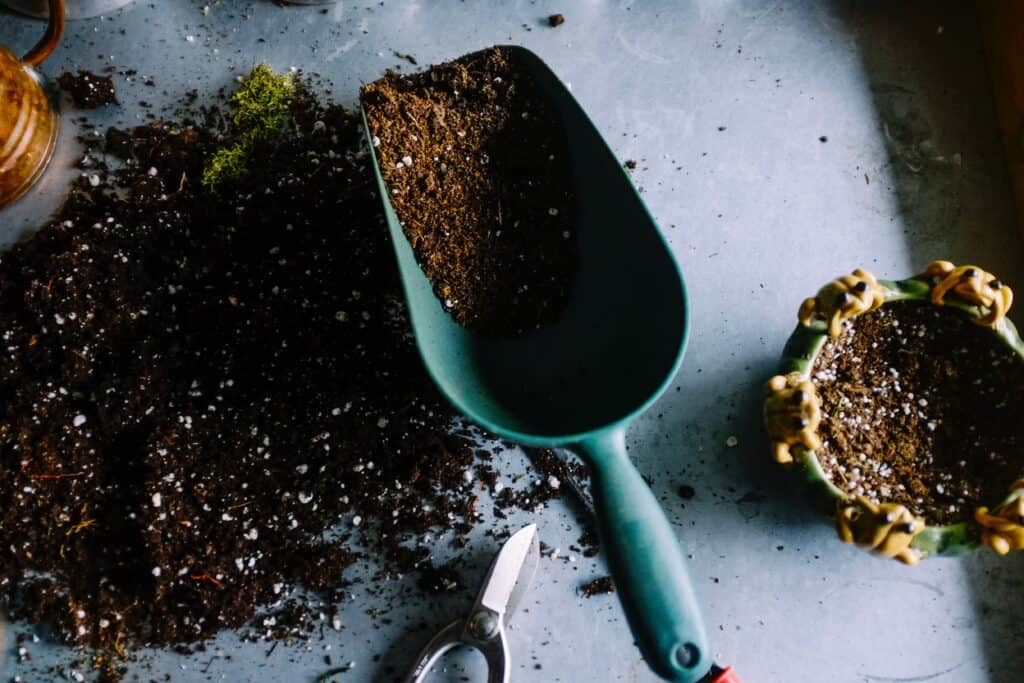
You can also use a clay pot, it would help absorb excess water. For ponytail palms, it’s highly advisable.
Step 3: Cut the Offsets and Prepare the Cutting
There are two ways of propagating ponytail palm plants through cutting.
1. Air Layering
If you want to make sure your baby ponytail palm plant survives, layering is the best way to go.
It is the technique of propagation where the baby ponytail palm plants form roots before you remove the offset from the mother plant.
Considering all other methods of propagation, layering has a greater chance of success.
The layering of ponytail palm plants is best done during the growing season, mainly in spring. For layering, you need sphagnum moss, a handful in quantity.
Use some water to moisten it and cover the base of the offset of your choice!
You can use some rooting hormones to dust around the bottom of the offset to promote root growth.
Moisten the moss when it seems dry.
Once the roots are visible to your eyes, you can cut the offset to provide them with a new home.
Point to remember: Air layering has higher propagation success than direct cut propagation.
2. Direct Cutting
To cut the offsets or the baby ponytail palm plant, choose the proper healthy offset first.
Firstly check if the offset is healthy and is not infected with any fungus or pests.
Before you cut, make sure the knife is sharp to cut without applying much pressure and damaging the parent plant.
Disinfecting the knife is also crucial before you cut because a non-sterile one risks infecting the plant.
Make a sharp cut just below the root base of the offset.
You need to apply some rooting hormone so that the ponytail palm baby plant forms roots.
Take a plate and pour some rooting hormone on it.
Dip or dust the cut part of the offset and check for even application around it.
Propagation of ponytail palms is not as easy as it sounds!
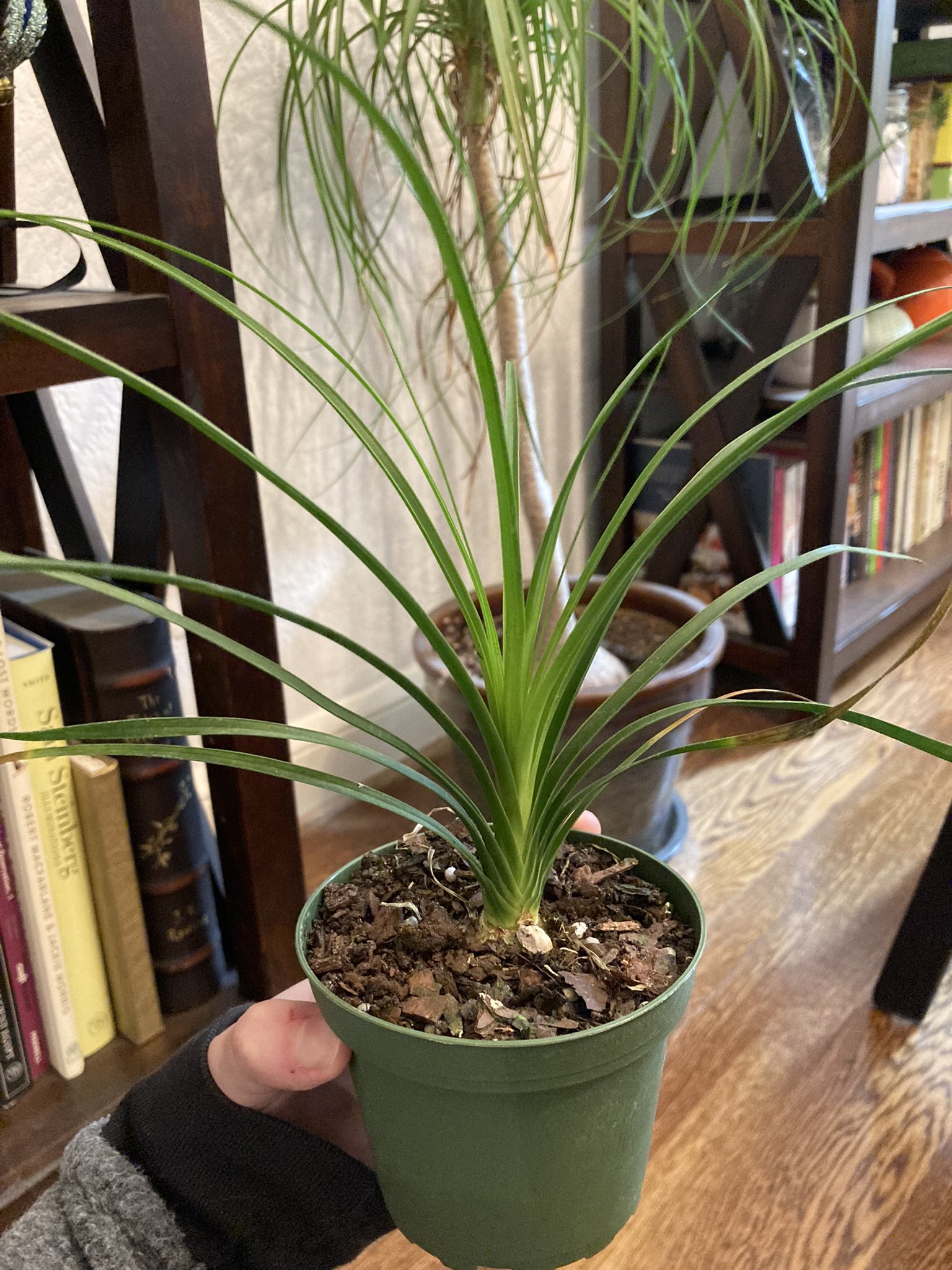
Step 4: Plant the Cutting
Once you have prepared the fresh cutting, it is ready to get planted in the soil.
Gently push the offset into the prepared soil mix so that the offset base is entirely in the soil.
Cover the base well with enough soil.
For the final step, water the newly transplanted plant, so the soil remains moist. However, do not overwater and make the ground wet or soggy.
Propagating Ponytail Palm Through Seeds
Ponytail palm plants grow well from fresh seeds. Sometimes called bottle palm, it is one of the best plants to have in your rooms!
The ponytail palm plant seeds sprout when they meet the suitable temperature, humidity, and water.
However, you may sometimes have to control the growing conditions to make sure the seeds sprout.
If you are propagating the ponytail palm through seeds, you need the following:
- Ponytail palm plant seeds
- Pot
- Growing mix
- Water
- Plastic cover
- Heating mat
Since the plant loves the warm weather so much, it’s always advisable to grow them during the warmth and sun of Spring if you are onto seeds propagation.
Here are the steps for propagating ponytail palm plants through seeds.
Step 1: Prepare the seeds
Before sowing, you need to prepare the seeds!
It is one of the primo steps while propagating ponytail palm plants through seeds.
Firstly, you need a bowl, which can be a small one, and warm water.
Further, you need to scarify the seed gently, so the tough coating gets slightly damaged, allowing the sprouts to emerge.
Pour the seeds into the bowl with warm water.
Now, gently place a wet sponge or a clean dishcloth above the seeds, making sure all the seeds are soaked and soaked beneath the surface of the bowl.
Alternatively, you can sprout the ponytail palm plant with a wet paper towel. Then, take two wet paper towels and place the seeds on them.
Cover the seeds with another wet paper towel. Don’t let the paper towel dry otherwise, and the seeds won’t sprout.
Within two weeks, you can see the seeds begin germination.
Step 2: Prepare the Growing Mixture
While preparing the growing mixture, you should know that ponytail palm plants prefer sandy or gritty soil.
Take a pot of a suitable size. Generally, sowing seeds in a 3-inch pot is preferred, so you don’t have to disturb the sprouts for quite some time.
Prepare the growing mixture with the following:
- 4 parts coarse sand
- Two parts peat
- 1 part perlite and
- 1 part sterile potting soil
When filling the pot, do not forget to leave the top 1/2 inch empty so that watering becomes easy and sand won’t overflow while watering.
Moisten the soil and let it dry for a few minutes before sowing the seeds.
Step 3: Sowing the Seeds
Now you are going to set ponytail palm seeds one by one.
After preparing the growing mixture and moistening the soil, it’s time to sow those seeds.
Place one seed at a time and gently press it into the growing mixture, half-buried. After that, you need to take a small amount of coarse sand and spread it gently over the seeds.
Use a little water to mist the sand to help them settle well.
While sowing the seeds, you need to be careful about maintaining some distance between each seed to avoid overcrowding.
Seed crowding will lead to competition for nutrients and water from the soil. Thus, all sprouts may not grow healthy.
Hence sow the seeds keeping some distance between them. However, if you have crowded sprouts, you can remove some of them to avoid overcrowding.
Make sure the new babies receive enough light and water!
Step 4: Maintain the Growing Environment
Ponytail palm seeds require a warm temperature and good sunlight to sprout.
So, using a heating mat is common if you want the seeds to sprout. In addition, hydrophobic mats are available so that you can control the temperature as the seedling desires!
You can create a miniature greenhouse by covering the pot on the top with a loose sheet of clear plastic.
Place the pot on a heating mat so that a temperature of around 70 degrees Fahrenheit is maintained.
Place the pot near the large window where it receives enough sunlight. Unfiltered sunlight is best for seed sprouting.
Step 5: Watering the Seeds
You need to pay attention while watering the seeds. It would be best if you used a spray bottle; it’s a complete necessity.
If you water the seeds directly, you can hurt the new sprouts with the water pressure.
If the surface of the growing mixture seems dry, water the seeds immediately.
Too much water can make the soil soggy, so it’s better to avoid that.
Also, do not let them dry out while the seeds are showing signs of germination.
Water them as they demand!
Step 6: Check the Sprouts Progress
Once you see the seeds sprout, gently and carefully remove the plastic cover and the heating mat as well.
Water them regularly, and check their progress.
You need to pay close attention to the sprouting for the first two months because you may have to water them if they dry out.
Once the seeds germinate, watering at the base of the seedling is best than spraying water from the top.
Step 7: Transplanting the Seedlings
Once the seedlings grow mature foliage, it’s time to provide them with a new home!
While you transplant them in a new pot, make sure to use fast-draining soil.
Place the plant in a spot where it receives enough sunlight because ponytail palm plants love warmth and sun.
Ponytail Palm Care For Newly Potted Plants
Ponytail palm plants require almost no care once they adapt to the new pot.
Newly potted ponytail palm can encounter problems like:
1. Sunlight Requirement
Ponytail palm grows well in bright sunlight.
Hence, provide bright enough, indirect sunlight. Once the plant adapts, direct sunlight cannot harm it.
Furthermore, ponytail palms do not like wet soil. Hence, enough light can dry the soil and reduce the effect of overwatering too.
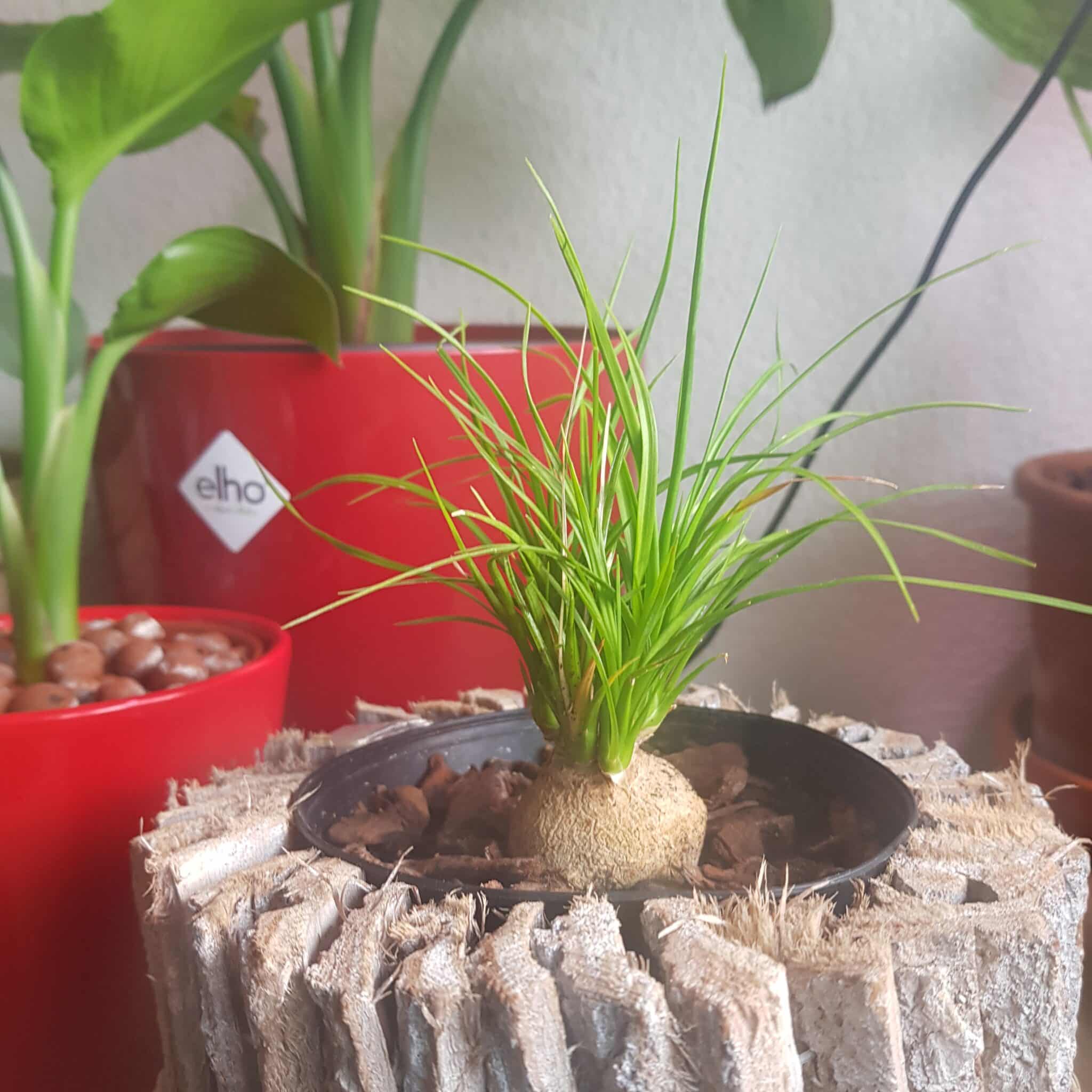
2. Temperature Requirement
Ponytail palms are succulents. Hence the plant thrives at a higher temperature.
During the winter, keep the plant away from the cold breeze in an area with good humidity.
3. Water Requirement for Ponytail Palm
There is a great chance you may overwater or underwater the newly potted ponytail palm.
Overwatering leads to stunted growth of seedlings. You can also notice some of the leaves starts turning yellow.
Wilting is the first sign that you are underwatering the plant. Underwatering leads to dry soil and slow growth of the seedlings.
During winter, water the plant occasionally as the plant demands.
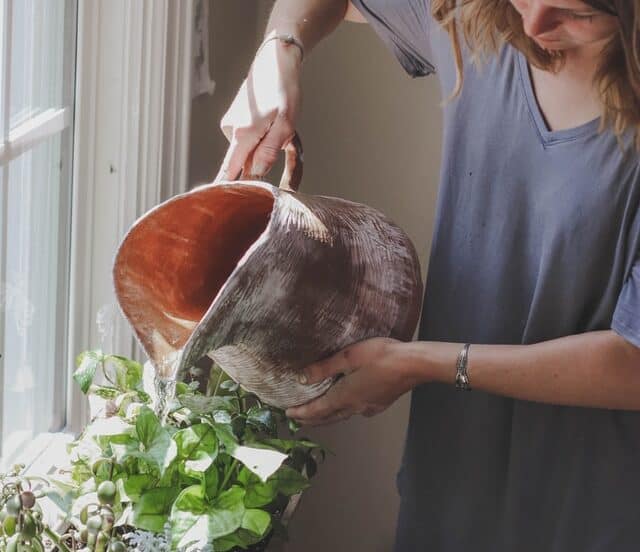
4. Fertilizer requirement
Like every house plant, ponytail palms need to be fed.
Fertilize with succulent and cactus fertilizer during the growing season. However, overfertilization can lead to brown tips.
Brown tips of leaves are considered tip burn due to salt build-up in the soil. Hence check your plants before feeding.

5. Check Out for Pests and Diseases
Ponytail palm is vulnerable to pests and disease if the soil dries between waterings.
Hence, you need to water the plant regularly and check for pests and diseases.
Stem or root rot, sooty mold, and botrytis blight are among the most common Ponytail Palm diseases.
A pest infestation is the root of most diseases that plague the ponytail palm plant.
Scale insects, mealybugs, spider mites, aphids, thrips, and other leaf-chewing insects that produce a honeydew-like fluid are the most common pests.
To get rid of them, water the plant before the soil completely dries out. You can also rub alcohol on the plant’s leaves or wash it with a warm soapy water solution.
Ponytail palm plants are the best low-maintenance plants for you.

Wrapping up…
The Ponytail palm plant is succulent. Once the newly potted plant adapts and begins to grow, it requires very little care.
If you are constantly traveling, ponytail palm plants are the best plant for you.
Growing new ponytail palm plants from their seeds needs more time, but it’s possible to get healthy baby plants.
Ponytail palm grows new pups often. Therefore, propagating them gives you a chance to fill your living space with baby plants.
Newly propagated ponytail palms can be a gift idea for your friend’s birthday or any other occasion.
Additionally, you can get a ponytail palm plant if you:
- Have to travel often due to work
- Are not a very good plant parent
- Fond of low-maintenance plants
